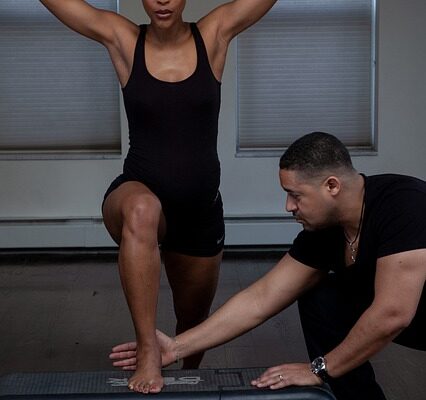Certain isometric workouts are particularly effective for increasing strength and muscular mass.
Muscular contractions are classified into two types: isometric and isotonic. Isometric muscular contraction happens when the muscles are engaged, but the joints do not move. Your limbs are immobile and do not lengthen or shorten the muscles. A plank or a wall seat are two nice examples.
Isotonic contractions occur when the joints move, and the limbs stretch or shorten as a result of eccentric or concentric contractions. Isometric and isotonic exercises are both necessary for strength development.
When most people think of strength-building workouts, they think of isotonic motions like squats, bicep curls, lunges, deadlifts, or bench presses.
Although these workouts are essential for increasing strength, muscle, and functional fitness, isometric exercises are also very helpful for increasing strength and muscularity.
The Advantages of Isometric Workouts for Muscle and Strength
Much research and anecdotal data from fitness professionals support isometric training. Here are a few examples:
Recruits Additional Motor Units

Isometric workouts have one significant advantage: they can activate nearly all possible motor units. Motor units are the driving power underlying all human movement, whether deliberate (walking, lifting) or involuntary (falling) (breathing, blinking).
Motor units also regulate the skeletal muscles, and your body adapts when you lift weights to the demands of the motor units. You will need to raise motor unit demands to maintain seeing success in your strength development.
Isometric exercises are ideal additions to strength training and muscle mass-building regimens since they are so effective at motor unit recruitment.
Isometric Workouts Aid in the resolution of sticking points
Another reason isometrics are particularly beneficial for strength gain is that they can assist lifters in breaking through strength training plateaus by targeting deficits at specific movement points.
For example, if you have difficulty lifting the bar past your knees in a deadlift (a common problem with this exercise), employing an isometric hold at the weakest location can help you gain strength in that area.
Muscle Hypertrophy is Increased
One of the essential aspects of muscle growth is time under tension.
While there are strategies that use time under tension, such as slowing down your reps, one of the simplest ways to increase time under tension is to use isometrics.
Isometrics clearly enhance time under tension because you hold the contraction without moving for a set period of time instead of moving in and out of isotonic contraction. You may mix the two for a variety of exercises, either with body weight or with external weights.
Enhances the Mind-Muscle Connection
The ability to intentionally perceive, feel, and use a muscle or group of muscles is essential for gaining strength and muscle. Isometrics, particularly during a general warmup or warmup set, may strengthen your connection to your muscles, allowing you to use them more effectively.
Certain muscles are more difficult for people to connect with and hence use properly when completing specific workouts. Some of us find it difficult to feel and engage the back body muscles during activities like rows, pull-ups, and pulldowns.
Holding the movement’s end contraction in an isometric hold can give your brain some time to recognize which muscles you’re attempting to activate, allowing you to feel and contract them more effectively during later concentric and eccentric movements in your workout.
Aids in the maintenance of strength throughout injuries
Regular loaded concentric and eccentric muscle contractions with isotonic training may be impossible or limited if you are injured. Isometric workouts can help you maintain your strength without exacerbating the injury.
Not only that, but isometric workouts with a limited range of motion during an injury can even lessen discomfort during the healing process.

5 Exercises for Isometric Workouts to Gain Strength
Planks: Planks are a traditional core workout. While the traditional plank is a good isometric hold for building core endurance, try the RKC plank (or active plank) to increase strength by pulling your toes and elbows toward each other, crunching your ribs toward your pelvis, and squeezing while holding the plank. You will only be able to do this for around 30 seconds.
Isometric bench press: Do a standard bench press with a significantly lighter weight. Pause for 2 – 3 seconds and hold the bar 2 – 4 inches above your chest.
Isometric squat: Squat with a barbell or dumbbell and hold the bottom position (or a sticking point) for 2 – 3 seconds. Train lighter than you normally would. Instead, perform a wall squat while holding a weight or using simply your body weight.
Isometric pull-ups: One of the finest strategies to improve your pull-up abilities is to train them isometrically. Simply grip the bar and contract without moving your body. Do it at the bottom of the pull-up with your back muscles contracted or at the top with your chin over the bar.
Hollow holds are an effective core stability exercise that can help avoid low back strain and increase strength. Most other lifting workouts require core strength.
Isometric push-ups: Isometric push-ups work your entire body. Descend into a push-up position and hold for 3 – 4 seconds before pushing back up.
Isometric lunge: Unilateral single-leg workouts are vital for developing muscle balance and stability. Try executing a lunge while holding the squat’s downward section. This is going to burn! You may only be able to hold for a few seconds at first but gradually increase to 5 – 6 seconds.
Isometric grip hold: Increasing your grip by strengthening your forearms, shoulders, and hands will help you improve other exercises like pull-ups and deadlifts. Stand side on to a barbell that is racked slightly below arm’s length. With one hand, pick it up in the center. Hold for 30 seconds before repeating with the opposite arm. As you develop, add weight to the bar.
Loaded carries: Loaded carries are an important movement pattern that should not be overlooked. Walking with a weight enhances functional strength, muscle growth, and stability. Loaded carry versions include farmer’s walks, suitcase carry, waiter’s carry, and others.

Isometric Programming: If you want to try incorporating isometrics into your normal workout routine for yourself or personal training clients, here are some ideas:
Reps with a pause: Pause repetitions are performed by pausing during a routine eccentric and concentric contraction movement. Pick a sticking place or the most difficult aspect of the action and wait for a count before continuing with the activity.
Loaded stretching: Holding a weight at the conclusion of a range of motion during an activity is known as loaded stretching. For example, during a chest fly, on the last rep, hold the dumbbells outstretched and count to 10 before finishing the exercise.
Holding contractions: This is ideal for activating muscles and establishing a mind-muscle connection prior to doing a specific lift. For example, during a cable row, pull the cable toward you and hold the contraction at the top of the exercise, feeling your shoulder blades draw together.
Supra-maximal loading: For this sort of isometric, you are preparing your central nervous system for enormous loads. Load a barbell squat or bench press with significantly more weight than usual, unrack it, and simply hold it in place without moving. It should be loaded with more weight than you can move; instead, you hold the weight in a locked position.
Isometric pulling and pressing: This sort of isometric is also excellent for priming your central nervous system and signaling that large loads will be moved. As an example, place a barbell on the floor and pull up on it as if performing a deadlift. The barbell is far too heavy to pull. Activate all of your muscles, maintaining tension all over your body and bracing your core. Lift up for several seconds with effort before releasing.
To Conclude
Isometric exercises can be included in a variety of training and rehabilitation programs.
In general, they need little space and no equipment and are simple to do in a variety of circumstances.
Although isometric exercises are generally easy on the joints, if you have an existing injury or are suffering discomfort in a specific section of your body, it’s a good idea to consult with your doctor or a physical therapist before beginning an exercise program that includes isometric exercises.
